Happy tenth birthday to viral online marketing.
On July 4, 1996, Hotmail founders Jack Smith and Sabeer Bhatia launched what's widely credited to be the first on-purpose Internet viral marketing campaign. Back then there was no online video, no easy peer-to-peer file sharing, no sophisticated games and practically no HTML email.
Instead, this groundbreaking campaign was a just a simple line of text stuck at the end of every single email sent that offered recipients their own free account.
Within 18 months the service had 8.7 million users, and Smith and Bhatia sold out for an estimated $400 million to MSN.
Now, tens of thousands of campaigns later, viral's settled into what you could call a rut. Despite the fact that every campaign's success depends on being so creative, so utterly forwardable, that consumers can't help but spread the news, most campaigns are cookie cutter.
You know the drill. The amusing video download, the interactive ecard, the engaging game, the forward-to-a-friend sweeps entry, etc. It's all getting a bit too boring for both marketers and consumers alike.
Can viral be saved?
We surveyed 790 MarketingSherpa readers with viral marketing experience and interviewed a variety of industry players to create this second annual report to help you.
First, the viral marketing survey results.March 11th we emailed an invitation to marketers involved in viral among our 237,000 readership to take our second annual survey. 790 responded (thanks) and here are the most interesting eight data charts from the results.

As we expected, business-to-business marketers continue to be primarily interested in using any and all types of advertising to generate new business leads. Unfortunately this goal often squashes the "viralness" of their campaigns because B-to-B marketers almost inevitably slam a required-registration form in front of their most tempting offers.
This chokes off response by an average of 94%, squeezing viral spread to a thin trickle. Continue reading for an example of a clever B-to-B software campaign that was the exception to this rule.

Glory be! The number we're most excited about here is the 10-point lift in marketers tracking the value of new email opt-ins. For far too long marketers have measured email success by the sheer size of their list, instead of by quality. Could this be a turning point for smarter email marketing?
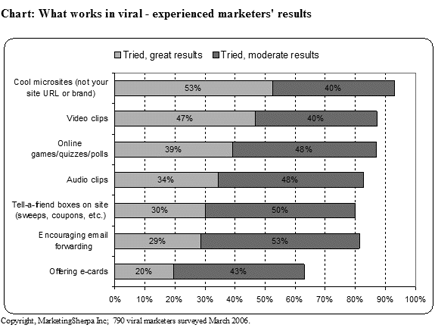
While online games have remained steady in value (last year 37% of surveyed marketers said they got great results), video clips are exploding in year-over-year value. Last year 31% of marketers said they tried video clips and they worked, now there's a 16-point lift.
We suspect much of this is associated with two specific industries -- automotive, where videos are now so normal that early-adopters BMW have pulled back from the tactic -- and porn, where video is well, an obvious creative choice. In the meantime, ecards continue to languish in the bottom spot. It's awfully hard to get this tactic to pay off anymore (see below for an example of one marketer who managed though).
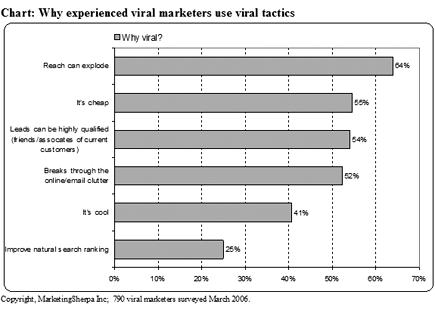
Interestingly, although only 25% of marketers hoped a viral campaign would improve their search rankings, 64% hoped their online reach would "explode." Um, guys, guess what getting higher search rankings does to your reach?!

Finally marketers are starting to understand that a great viral campaign might actually cost, gulp, money. According to our what-works-best data above a cool microsite, although more expensive than many tactics, is definitely a great investment.
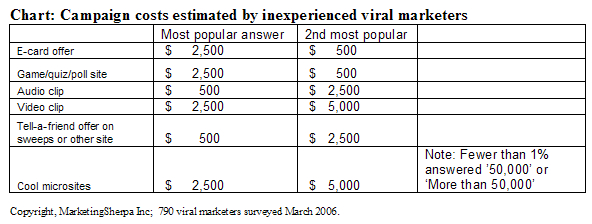
And for the second year in a row, marketers without significant personal experience in viral have oddly tiny cost expectations.
We suspect the paying-for-viral world breaks down into three camps of marketers:
#1. $50,000 is pocket-lint: These are often major consumer brands who spend millions on broaedcast media. Five figures for a what-the-heck viral test is pocket lint for them. Unfortunately, they're the hardest clients to create so-cool-it-virals campaigns for because they're leery of brand damage. And viral campaigns created by committee are the worst campaigns of all.
#2. Casinos and porn: These marketers are spending so much per lead (sometimes $50-$150), they'll happily sign up for any campaign that could produce a better ROI. Plus, while they want their brand names to be more famous, they don't mind what sites they appear on. Nobody flinches at the idea of buying media on MySpace.com to support the campaign.
#3. The little guy (with the little budget): Your typical bargain shopper, this is the marketer who must get a ROI from this campaign or lose his or her job trying. Often they are an unknown or little known brand trying to break out from the pack. They can't outspend Fortune 500 competitors, so they try to out-viral them. And, sometimes it works.
The Japanese trend of paying for performance for viral campaigns may trickle westward to help this group. It's easier to sell your boss on a pay-for-performance campaign than an up-front investment, even if at the end you may pay more. But, expect the agencies offering this payment model to demand a higher degree of creative control. Just make sure the "performance" is measured against your target demographic and not the entire universe.
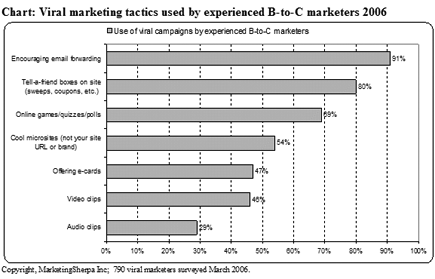
For the second year in a row, MarketingSherpa's research team is disappointed by the number of marketers trying audio. We think audio rocks with demonstrated potential. Ever heard of podcasting? Or audio file sharing? Hello -- is anyone out there?
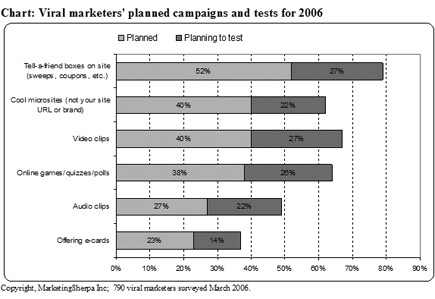
As expected, video clips are a solid winner coming only second to tell-a-friend boxes. However, we have to wonder, who hasn't been sticking tell-a-friend all over their sites for the past decade? This tactic is as old as the hills. Just make sure your system is set up in such a way that email filters don't stop the majority of the messages visitors use your system to send. Trust us, it happens far more than you think.
Biggest year-over-year change: Seeding tactics"There has been a huge shift in last 12 months. The way users connect and share content has changed radically," says Justin Kirby, co-author of the new book 'Connected Marketing: The Viral, Buzz and Word of Mouth Revolution.'
Why the big change? Although build-your-own-site networks and social networking services are nearly as old as viral marketing itself is, they've only become insanely popular in the past 18 months. (Sherpa suspects this bubble is in part driven by blogging finally hitting household-name-status in the mass market.)
According to Nielsen/Netratings, seven of the top 10 fastest growing Web brands online for November 2005 were user-generated content and social networking sites, which boasted the following year-over-year monthly unique visitor growth rates.
PhotoBucket - 1492%; MySpace - 752%; Facebook - 530%; LimeWire - 345%; Heavy.com - 301%; Wikipedia - 291%; Mate1.com - 265%.
Which demographic uses these sites the most? Here's comScore data for some of the top social networking sites.
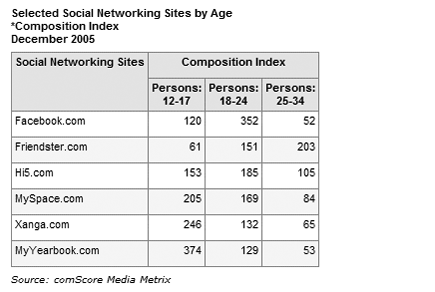
Note: The numbers above are a composition index (CI) representing the proportion of the given group within a specific site audience, compared to the proportion of that group in the total online population. A CI of 100 represents parity. Anything well over or under 100 is eyebrow raising.
Plus, next-generation social networking sites are already well over the event horizon. Tagging sites such as del.icio.us and flickr.com are all the rage among the blogging cognoscenti. In turn, their users are often the most influential Web surfers for their own demographic circles.
Soon if your viral campaign isn't tagged, mentioned in consumers' blogs, featured on individuals' online profile pages, and cross-posted by fans on free download sites, it won't be hot.
Kirby agrees. "The likes of MySpace, YouTube, flickr, Google Video, etc., have changed the landscape and few practitioners have kept up with the changes. You can no longer rely on the usual viral format suspects and seeding tactics as they are beginning to look very tired after 10 years, some comatose."
How can you win in the new viral world? "It's about doing new and different things, and working with actual influencers in communities rather than just creating a funny video or game and paying Bore Me or Kontraband to feature it," says Kirby.
Five tips to start with:
#1. Consider building a campaign specifically with MySpace or one of the other networking sites in mind.
Example: Date Movie's microsite created by Organic and Deep Focus features a page with offers to help visitors improve their MySpace profiles. (Link below.)
#2. Add a semi-secret layer to the creative that only the proud-to-be-insiders of your demographic might notice. Then let them discover the secret for themselves…. They may proudly blog or post notes about the fact that they found the secret.
Example: When agencies Thundar Sky Pictures and Captains of Industrt created a viral campaign for business-to-business software firm LiveVault, the video 'Institute for Backup Trauma' featured John Cleese. But, they also included a Star Trek actor as an unannounced cameo in street clothes. Cleese's star power guaranteed the video a quick PR hit, but the Star Trek "secret" kept the video alive in bloggers' discussions for months on end. (Link below.)
#3. Celebrity always sells. "We allowed users to add audio files of their text spoken by celeb soundalikes to ecards. Cost was high, but pass-along rate was nuts. And we are finding the audio files hosted on over 3,000 sites with the little research we have done," one MarketingSherpa survey respondent wrote.
Data MarketingSherpa obtained from PRWeb in August 2005 showed celebrity-related press releases were the most likely to be read by online news viewers and least likely to be search engine optimized by their authors. Take advantage of this omission before it ends.
So, if you have any celebrity connection whatsoever (beyond the "secret" kind), issue a press release featuring a hotlink to your landing page in the first paragraph on the wire services ensuring pick-up by Google News, Yahoo News, MSN News, and then inevitably a plethora of bloggers and sploggers.
#4. Don't forget to brand your creative in such a way that cutting your offer or logo out of it is next to impossible. As Justin Sewell, President of funny-poster ecommerce site Despair.com discovered, consumers will have no compunction about downloading your content and posting it on their own site without the logo or hotlinked attribution.
Your campaigns' biggest fans don't know they are eviscerating your results or business model. Stop them before they start.
#5. Include three super-basic (but oft forgot) hotlinks next to your creative or offer: Forward to a friend, permanent link and add post to del.icio.us
And if you've done an outstanding job with a creative viral campaign in the past year, don't forget to nominate yourself as an inspiration for other marketers in our Hall of Fame. Nominations are free -- see link below… Note: In Part II coming next week, we'll profile the top 12 viral campaigns of 2006.
Useful links related to this articleLast chance - if you've conducted a great viral campaign in the past 12 months, here's the free nominations link for MarketingSherpa's annual Viral Hall of Fame http://s-sm608-145.sgizmo.com (Deadline Monday April 3rd midnight New York Time)
Date Movie's Viral MySpace Profile Improvement Offer http://www.datemoviethemovie.com/pimpmyprofile/
LiveVault's Backup Trauma Viral Video http://www.backuptrauma.com/video/default2.aspx
Viral Chart -- a firm offering tracking services to viral marketers, plus handy online charts of top-campaigns http://www.viralchart.com
del.icio.us http://del.icio.us
MySpace http://www.myspace.com
comScore http://www.comscore.com
MarketingSherpa's 2005 Viral Marketing Report -- features still-useful practical tips for the top five viral tactics: http://www.marketingsherpa.com/article.php?ident=23870




 Interestingly, although only 25% of marketers hoped a viral campaign would improve their search rankings, 64% hoped their online reach would "explode." Um, guys, guess what getting higher search rankings does to your reach?!
Interestingly, although only 25% of marketers hoped a viral campaign would improve their search rankings, 64% hoped their online reach would "explode." Um, guys, guess what getting higher search rankings does to your reach?!  Finally marketers are starting to understand that a great viral campaign might actually cost, gulp, money. According to our what-works-best data above a cool microsite, although more expensive than many tactics, is definitely a great investment.
Finally marketers are starting to understand that a great viral campaign might actually cost, gulp, money. According to our what-works-best data above a cool microsite, although more expensive than many tactics, is definitely a great investment.  And for the second year in a row, marketers without significant personal experience in viral have oddly tiny cost expectations.
And for the second year in a row, marketers without significant personal experience in viral have oddly tiny cost expectations.  For the second year in a row, MarketingSherpa's research team is disappointed by the number of marketers trying audio. We think audio rocks with demonstrated potential. Ever heard of podcasting? Or audio file sharing? Hello -- is anyone out there?
For the second year in a row, MarketingSherpa's research team is disappointed by the number of marketers trying audio. We think audio rocks with demonstrated potential. Ever heard of podcasting? Or audio file sharing? Hello -- is anyone out there?









